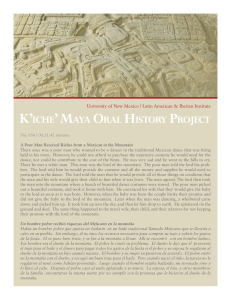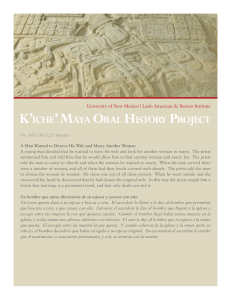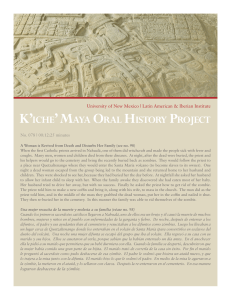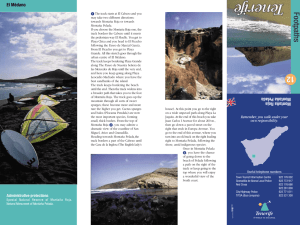103. Cómo se sabe que las montañas tienen dueños
Anuncio
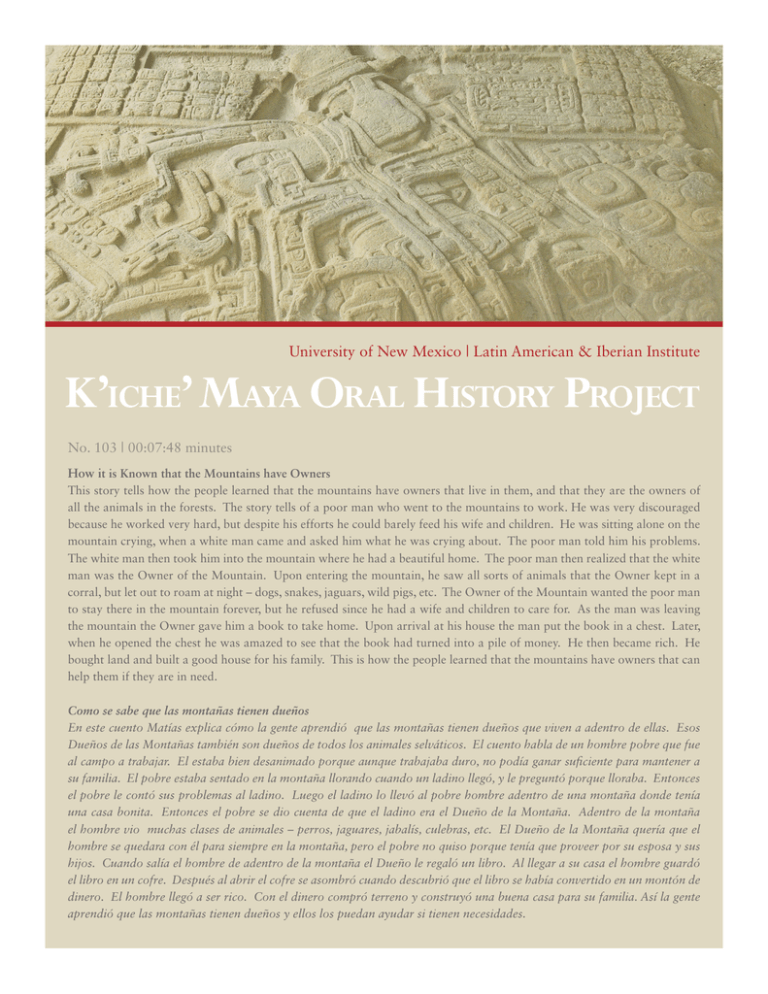
University of New Mexico | Latin American & Iberian Institute K’iche’ Maya Oral History Project No. 103 | 00:07:48 minutes How it is Known that the Mountains have Owners This story tells how the people learned that the mountains have owners that live in them, and that they are the owners of all the animals in the forests. The story tells of a poor man who went to the mountains to work. He was very discouraged because he worked very hard, but despite his efforts he could barely feed his wife and children. He was sitting alone on the mountain crying, when a white man came and asked him what he was crying about. The poor man told him his problems. The white man then took him into the mountain where he had a beautiful home. The poor man then realized that the white man was the Owner of the Mountain. Upon entering the mountain, he saw all sorts of animals that the Owner kept in a corral, but let out to roam at night – dogs, snakes, jaguars, wild pigs, etc. The Owner of the Mountain wanted the poor man to stay there in the mountain forever, but he refused since he had a wife and children to care for. As the man was leaving the mountain the Owner gave him a book to take home. Upon arrival at his house the man put the book in a chest. Later, when he opened the chest he was amazed to see that the book had turned into a pile of money. He then became rich. He bought land and built a good house for his family. This is how the people learned that the mountains have owners that can help them if they are in need. Como se sabe que las montañas tienen dueños En este cuento Matías explica cómo la gente aprendió que las montañas tienen dueños que viven a adentro de ellas. Esos Dueños de las Montañas también son dueños de todos los animales selváticos. El cuento habla de un hombre pobre que fue al campo a trabajar. El estaba bien desanimado porque aunque trabajaba duro, no podía ganar suficiente para mantener a su familia. El pobre estaba sentado en la montaña llorando cuando un ladino llegó, y le preguntó porque lloraba. Entonces el pobre le contó sus problemas al ladino. Luego el ladino lo llevó al pobre hombre adentro de una montaña donde tenía una casa bonita. Entonces el pobre se dio cuenta de que el ladino era el Dueño de la Montaña. Adentro de la montaña el hombre vio muchas clases de animales – perros, jaguares, jabalís, culebras, etc. El Dueño de la Montaña quería que el hombre se quedara con él para siempre en la montaña, pero el pobre no quiso porque tenía que proveer por su esposa y sus hijos. Cuando salía el hombre de adentro de la montaña el Dueño le regaló un libro. Al llegar a su casa el hombre guardó el libro en un cofre. Después al abrir el cofre se asombró cuando descubrió que el libro se había convertido en un montón de dinero. El hombre llegó a ser rico. Con el dinero compró terreno y construyó una buena casa para su familia. Así la gente aprendió que las montañas tienen dueños y ellos los puedan ayudar si tienen necesidades. UNM LATIN AMERICAN & IBERIAN INSTITUTE Project Background The stories and rituals included in this collection were collected between 1968 and 1973. All of them are narrated in the K’iche’ Maya language of Guatemala with almost all of the narrators speaking the Nahualá-Santa Catarina Ixtahuacán dialect of that language. Collected and recorded by Dr. James Mondloch Transcribed by Miguel Guarchaj Ch’o’x and Diego Guarchaj Funding and support provided by The UNM Latin American and Iberian Institute and the US Department of Education Title VI National Resource Center grant. Title page image provided courtesy of Dennis G. Jarvis Usage rights Copyright © 2011 The University of New Mexico, Latin American and Iberian Institute. All Rights Reserved. You may print, reproduce and use the information in, and retrieve files containing publications or images from, The University of New Mexico’s WWW documents for non-commercial, personal, or educational purposes only, provided that you (i) do not modify such information, and (ii) include any copyright notice originally included with such information and this notice in all such copies. Alternative formats In accordance with the Americans with Disabilities Act, the information contained herein is available in alternative formats upon request. Additional information about this project is available online http://laii.unm.edu/kiche Correspondence should be directed to The University of New Mexico Latin American & Iberian Institute 801 Yale Boulevard NE / MSC02 1690 1 University of New Mexico Albuquerque, New Mexico 87131-0001 Phone: (505) 277-2961 Fax: (505) 277-5989 E-mail: [email protected] Web: http://laii.unm.edu
